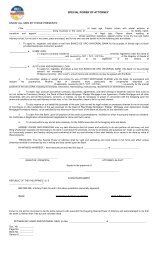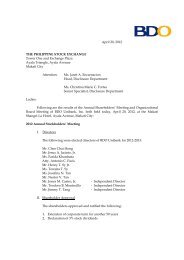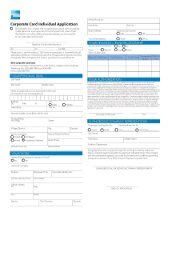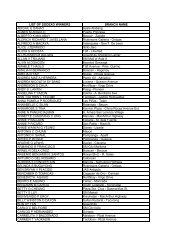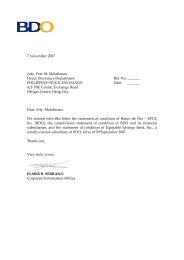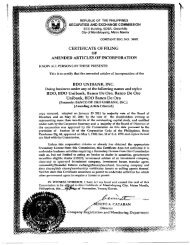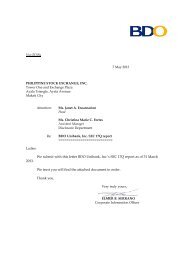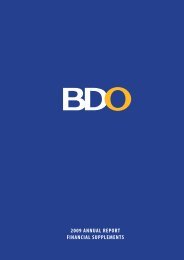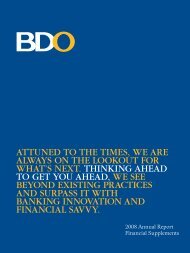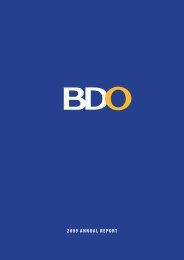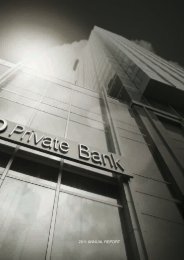2010 BDO Annual Report
2010 BDO Annual Report
2010 BDO Annual Report
Create successful ePaper yourself
Turn your PDF publications into a flip-book with our unique Google optimized e-Paper software.
We find ways<br />
Review of <strong>2010</strong> Operations<br />
Economic Environment<br />
Posting Gains on Solid<br />
Fundamentals<br />
The Philippine economy recorded its best performance in over three decades with a<br />
7.3% growth in gross domestic product (GDP) in <strong>2010</strong>, surpassing the government’s<br />
initial target of 5% to 6%.<br />
This growth was bolstered by:<br />
<br />
<br />
<br />
Market pundits said the strong<br />
fundamentals of the Philippine economy<br />
allowed it to expand and triumph over<br />
a challenging external environment<br />
caused by a weak US recovery, lingering<br />
European sovereign debt crisis, rising<br />
global inflation pressures, as well as<br />
capital influx from the impact of US<br />
Quantitative Easing (QE2), a monetary<br />
policy used by some Central Banks to<br />
stimulate the economy.<br />
Consumption spending in <strong>2010</strong><br />
rose 5.3 % on the back of low inflation<br />
and interest rates, as well as higher<br />
remittances from the Overseas Filipino<br />
Workers (OFW) and steady revenues<br />
from the Business Process Outsourcing<br />
(BPO) sector. And with the renewed<br />
investors’ confidence following the<br />
election of Benigno “Noynoy” C.<br />
Aquino III as the 15th President of the<br />
Philippines, fixed investments increased<br />
17% channeled largely to construction<br />
and durable goods to meet growing<br />
demand.<br />
Election spending created demand<br />
for campaign-related goods and<br />
services, generating seasonal jobs and<br />
extra incomes. Government spending<br />
was frontloaded in the first half of the<br />
year to rebuild the areas damaged by<br />
typhoons Ondoy (“Ketsana”) and Pepeng<br />
8<br />
(“Parma”) that hit the country in late 2009.<br />
Meanwhile, exports grew 26% in <strong>2010</strong><br />
on inventory restocking and increased<br />
external demand following the global<br />
downturn in 2009.<br />
The broad-based demand showed in<br />
the favorable performance in industry<br />
and services. Among the industry<br />
sectors, manufacturing and mining were<br />
clear winners with annual growth rates<br />
of 12.3% and 18.4%, respectively, as these<br />
benefited from the big export rebound<br />
and favorable global prices. Meanwhile,<br />
services grew by 7.1%, led by real estate,<br />
trade, and private services. Only the farm<br />
sector posted a decline due to the impact<br />
of the El Nino.<br />
INFLATION<br />
Gross Domestic Product<br />
1.1%<br />
2009<br />
7.3%<br />
<strong>2010</strong><br />
From a high of 4.4% in April and May,<br />
the headline inflation rate settled at 3%<br />
in November and December on stable<br />
food prices, electricity rate cuts, and price<br />
rollbacks for socially sensitive products<br />
kerosene and liquefied petroleum gas<br />
or LPG. The peso appreciation also<br />
tempered the impact of imported inflation<br />
notwithstanding rising global commodity<br />
price pressures. The average inflation rate<br />
was 3.8% for <strong>2010</strong> versus 3.2% in 2009,<br />
falling near the low end of the Bangko<br />
Sentral’s 3.5%-5.5% inflation target.<br />
FOREIGN EXCHANGE<br />
The peso strengthened to P43.88/US$1<br />
by year-end <strong>2010</strong> from the P46.36/US$1<br />
end-of-period rate in 2009; while the<br />
average foreign exchange rate rose 5.6%<br />
to P45.11/US$1 in <strong>2010</strong> from P47.64/US$1<br />
in 2009.<br />
The peso’s strong performance was<br />
boosted by the strong OFW remittances<br />
(+8.2% year-on-year to US$18.8 billion);<br />
higher BPO incomes (US$9.0 billion);<br />
and increased export earnings (US$51.4<br />
billion in <strong>2010</strong> vs. US$38.4 billion in 2009).<br />
Further adding to dollar liquidity was<br />
the surge in portfolio investments to<br />
US$4.6 billion in <strong>2010</strong> from just US$388<br />
million the previous year. Foreign capital<br />
had shifted to emerging markets like the<br />
Philippines that offered higher yields<br />
compared to the near-zero interest<br />
rate in the US following the US Fed’s



